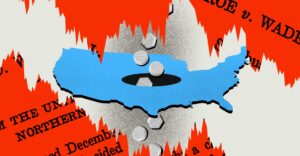A few years ago, there was an easy, healthy overlap between the kind of television beloved by those who talk about TV as professionals and the kind beloved by those who talk about TV as enthusiastic amateurs. TV seemed to abound with shows that both racked up high scores on Metacritic and had highly engaged fanbases. When new episodes dropped, fans and critics alike would turn up on Twitter to discuss their faves: Succession and Schitt’s Creek and Ted Lasso and Game of Thrones and on and on.
June 16, 2024:
You were gathering around the digital water cooler, and you were doing it with a show that everyone agreed was more than just a guilty pleasure. It was art. Yet somehow, without anyone quite noticing it had happened, the TV shows we watch like that seem to have vanished.
There’s still good TV out there (Abbott Elementary, Somebody Somewhere, the recently completed Reservation Dogs), and there are still shows that lots of people watch and talk about (Bridgerton, mostly), but the overlap in the Venn diagram of “critical consensus hits” and “watercooler discourse bait” is getting smaller and smaller. At this point, all that’s really occupying the niche is The Bear.
In April, New York Times TV critic James Poniewozik labeled our current era of television “the golden age of Mid TV.” Mid TV, according to Poniewozik, is “what you get when you raise TV’s production values and lower its ambitions. It reminds you a little of something you once liked a lot. It substitutes great casting for great ideas.” Mid TV is the Amazon Prime Mr. and Mrs. Smith TV show, with likable stars and high production values and a plot you might not care that much about but that you can pretty much follow while you fold your laundry.
It’s true that mid TV is taking up valuable space in the ecosystem where the great watercooler shows used to live. Yet I think there’s more to the story than that. Here are the reasons, as best I can tell, that the great watercooler show has become an endangered species.
After the writers strike, the TV landscape is different

One reason that there aren’t many great watercooler series this year may be simply that there isn’t as much TV this year as usual. The number of TV shows in production has been dropping since it peaked in 2021, and the 2023 writer’s strike only exacerbated the trend. According to a recent study from FilmLA, television production in the first quarter of 2024 was down by 16.2 percent from the same period last year, and down 32.8 percent from its five-year average. Statista shows a total of 516 scripted TV shows in 2023, down from 600 in 2022. If there’s less television across the board right now, it follows that there would be less good and buzzy TV, too.
Still, 516 shows on the air in 2023 is considerably more TV than we had in 2009, when there were a measly 210 shows on the air. Yet in 2009, Mad Men and Breaking Bad were both on the air. So were 30 Rock and Parks and Rec, not to mention Lost and Friday Night Lights and Community and Battlestar Galactica — all shows that could find comfortable spots in a “top 100 TV shows of all time” list, and which were heavily discussed when they aired to boot.
It’s instructive, then, to look not just at the world the writers strike built, but also at some of the conditions that led to the strike. One of the sticking points for the Writer’s Guild in 2023 was the rise of so-called “mini rooms” as an increasingly standard practice over the last 10 or so years as the streaming platforms began to build their libraries. A classic TV writer’s room can include seven or eight writers, but mini rooms include only two or three writers plus a showrunner.
Mini rooms typically emerged when a show was in limbo waiting to be greenlit, either for production or for a new season. The idea was that the showrunner could take on a few extra writers and a few weeks to plan the season they were pitching, which executives would then evaluate before they committed to filming episodes. The writers for a mini room were hired as freelancers and paid to scale, and there was no guarantee they would stick around if the show continued on to regular production. One of the biggest issues with this practice, the WGA argued, was that mini rooms cut young writers off from the classic apprenticeship system of TV writing.
Young writers were by and large not attractive to showrunners who needed to staff up a mini room to churn out a season’s worth of scripts fast. If young writers did get hired, they didn’t get mentorship from the older and more experienced writers they were working with, because those writers didn’t have time for it. By the time the episodes they wrote went into production, they were no longer working for the show and had no chance to come to the set, see how their script worked in practice, and adjust their practices for the future based on the new information.
The new WGA contract essentially killed off mini rooms, but for the next few years, we’ll be living in the creative ecosystem they birthed. That’s a world where upcoming talent had limited opportunities to learn the craft of their medium, and it has started to show.
I recently sat through Hulu’s Death and Other Details, an expensive-looking murder mystery starring Mandy Patinkin and a host of big names that fits right into Poniewozik’s rubric of mid TV. It was riddled with the kind of basic errors that even bad TV shows used to know how to avoid, mistakes that feel like not knowing a period is supposed to go at the end of the sentence. The act breaks all fell in the wrong place so that they killed tension instead of heightening it. Murder suspects would learn crucial information offscreen instead of onscreen, where the audience could see their reaction and evaluate how suspicious they were. Mysteries have a formula, and the people who made them used to know that. Now, that kind of basic knowledge is a lot less widespread than it used to be.
Making good television is a skill, and so is making alluringly addictive television. The industry hasn’t been set up to nurture either ability for a while.
First, prestige TV meant antihero shows. Then it meant sweet shows. What does it mean now?

For a good 15 years, the most prestigious genre of television bar none was the antihero show: Cable shows about darkly compelling men performing darkly compelling deeds. The Sopranos, Mad Men, Breaking Bad. This was the kind of TV that had critics writing rhapsodic essays about how what the novel was to the 19th century, television was to the 21st. It was the kind of TV that had audiences glued to their television sets while the show was on the air and to their computers, discussing the details, when it wasn’t.
Then came Trump, and antihero shows became abruptly less appealing for large swathes of the audience. Who wanted to find themselves deliciously tricked into sympathizing with a mobster when it feels like there’s a mobster in the Oval Office, and he’s a lot less psychologically interesting than Tony Soprano? In the Trump era, the TV that flourished was sweet-natured shows about humanity’s quest for self-betterment, like Schitt’s Creek or The Good Place. By the time the trauma of the pandemic hit in 2020, practically the only watercooler show America could handle was gentle Ted Lasso.
Now, in the diffuse and shapeless post-vaccine Biden era, both antihero shows and sweet shows seem to have run out of steam. Ted Lasso is over, and it has left little cultural footprint behind it. Succession, the last of the great antihero shows, has run its course. In the absence of either genre, it’s hard to tell exactly what the national mood will center around next.
TV has tried other things: adapting our favorite video games, going back to the historical well, and playing with the conventions of reality TV. Yet none of these new experiments have quite hit and stuck the way the flagship shows of other eras have. They’ve been moderately buzzy, moderately talked about, moderately admired. We watch them, discuss them briefly, and then move on to other things.
Thus far, the show with the most staying power is The Bear, which notably isn’t so much of a new genre as it is an alchemical mixture of our old favorites. In each of the two seasons that have aired so far, most of the arc plays as feel-good, only to reveal antiheroic curdling at the end, when Carmy’s demons come out to play. Still, it’s hard to imagine that this hybrid model is replicable for many other shows. We’re left in a space in which it’s not quite clear what a great watercooler show should look like — which might make one hard to recognize when it comes.
Post-peak TV, everything is splintered
If part of the issue we’re talking about here is that there’s no longer a strong overlap between the shows critics are excited about and the shows audiences want to talk about, a major culprit is that the platforms have splintered. All of them: the platforms that produce television, the platforms that produce criticism, and the platforms where audiences talk about TV.
When the golden age of television started in the late 1990s, all you needed to keep on top of good TV was a premium cable package that included HBO. When streaming entered the game in the early 2010s, you could get by with a basic Netflix subscription for $8 a month, maybe a Hulu subscription if you were a true TV buff. Now, there’s still cable and there’s still Netflix and Hulu — but there’s also Prime and Paramount+ and Disney+ and Apple TV+ and Peacock and Max. Oh, and if you want to keep your Netflix subscription fee low, you have to watch ads now.
It’s all a lot, way more than most people can keep track of. A 2023 Nielsen report found audiences now spend an average of 10.5 minutes searching for something to watch every time they sit down. At least one in five audience members have been so overwhelmed with all the choices the post-streaming world has for them that they’ve chosen to forgo TV to do something else instead.
Under these circumstances, it takes a lot for any one individual show to cut through the noise and find a critical mass of people waiting to watch it, much less discuss it. When they do decide to discuss it, they’re going to different places than they used to.
Part of the fun of the golden age of television was the rise of the TV recap. Sites like Television Without Pity and the A.V. Club nurtured a generation of critics to analyze and critique each episode of a given show as it aired. The recaps would become the default discussion space for audience members, too, with fans gathering in the TWOP forums and the A.V. Club comment section and, eventually, the critics’ Twitter mentions. Audience conversation and critical conversation fed each other and were part of what made the medium feel alive and vital.
Television Without Pity shut down in 2014. The A.V. Club was passed from one media company to another, with a brief period last year of publishing AI-generated content ripped from IMDB. (New owner Paste Magazine has pledged to scrub away all AI content in an attempt to win back reader trust.) Twitter’s dedicated user base has gone shaky ever since Elon Musk turned it into X. Today, audiences are likely to limit their conversations to subreddits and private Discord channels, far away from critics. The conversation between the two groups has been blocked off, which means both groups are quieter than they used to be.
Increasingly, I’ve come to think that the most interesting and exciting TV right now is happening in weird little niches that cultivate hyper-enthusiastic fandoms but never quite manage to dominate the conversation in a way that shows like Succession did. Last summer, I had a brief but passionate love affair with Mrs. Davis, a Peacock original limited series about a horse-riding nun on a mission to take down a world-dominating AI. It was batty and glorious and I never found anyone else who wanted to talk about it, but I loved it with my whole heart.
Maybe that’s what TV looks like right now: small shows that we love and keep close to ourselves like a favorite book, and big shows that we watch and talk about and immediately forget. It feels like it will be a while before a big show is good enough to change the way our TV ecosystem works all over again.


























